View current page
...more recent posts
guthrie says on his del.icio.us page: "...youtube is totally reaching its golden peak (like napster did..), really gotta download all my favorites before they vanish....."
No kidding. They're vanishing as fast as copyrightholders decide they have had enough free (grainy) exposure. As far as saving them, the thing is, you won't, and I won't. File that under the best of intentions.
I have some Quicktime vids that I created up on this page--this marks me as a pre YouTubian dinosaur, yet most have been made since 2005.
I avoided YouTube because I dreaded that uniform rectangle and feared the Procrustean distortions that odd-sized formats would suffer. Also, I knew some evil f*ckw*d like Rupert Murdoch would end up with all my content on his server. Turns out it's google, but I don't have a gmail account, either.
I'm enjoying the YT ride, finding out what bands actually look like that I listened to a million times on vinyl and CD, and otherwise glomming onto bits of my cultural heritage, past and present. I'm filing them away in my mind because I don't trust that I'll find them again.
update: some ordinary vulgarities trimmed so the blog maintains its lofty tone

another lunchbox from Kristin Lucas' Happy and Sad Sack Lunch Series 2005...

...and an inhaler.
YouTubin' by categories (mine)
* removed thanks to some dildo
**removed by user
Tornados
Near Attica KS, May 12, 2004 (watch house get sucked up into sky)
New Wave/Postpunk
Throbbing Gristle Discipline
Wall of Voodoo Ring of Fire (live)
Tuxedomoon Desire / Jinx / In a manner of speaking
Suicide Ghost Rider ("America, America is killin' its youth") ('77-'78) / Another version
King Crimson *Elephant Talk
Progressive/Psychedelic Rock
Gentle Giant Give It Back
Van der Graaf Generator A Plague of Lighthouse Keepers, Part 4
*Yes Astral Traveler
*Procol Harum Homburg
Anime
Wings of Honneamise Opening credits (music by Ryuichi Sakamoto--wish the resolution on the ink wash drawings was better)
Excerpt from Patlabor 2 (dialogue dubbed in German)
*Another Patlabor 2 Silent Tokyo
Gunbuster - Buster Beam / Die Buster
Film
John Carpenter Dark Star Trailer
*Deleted Bank Robbery Scene from Escape from New York
Tarkovsky - Stalker - the rail trip into The Zone
Art
Robert Smithson Spiral Jetty (excerpts)
"Prophet without honor" award to George A. Romero for his 1973 no-budget movie The Crazies. He lives in Pittsburgh and doesn't have Hollywood smoothies vetting his pictures so he gets to say anything he wants. The premise of this one: plane carrying US government-developed bioweapon crashes near a small Pennsylvania town. The pathogen--an "encephalitic mutation"--causes insanity that either comes on full strength or appears intermittently but eventually results in death, after several days. The bug gets into the town's water supply. The government is late on the scene and the best it can hope to do is declare martial law, round up all the citizens, and contain them in the local high school gym while searching for an antidote or an immune person. The Army, wearing hazmat suits, enters into pitched battles with the locals, crazy and not crazy, many of whom are armed and don't want to be "rounded up."
The main protagonists are a group of sympathetic townspeople, including two firemen who are 'Nam vets, who don't know the full symptoms of the virus or which of them might be infected but attempt to blow town. If they succeed, it means "breaching the perimeter" and spreading the infection to other cities. Suffice it to say, in a packed 90 minutes, everything that can go wrong does go wrong and the film is nonstop strife and carnage--but funny, too, that's Romero's gift. The main "villain" is the bumbling ineptitude of the Army and the utter callousness of the government towards the townspeople.
What seemed like overwrought science fiction in the '70s has become all too familiar in the '00s with the neglect that led to 9/11, the government's abandonment of New Orleans to chaos, the Washington sniper, anthrax, and the devastation in Iraq. What The Crazies does is wrap all this horror in one explosive package. A movie like this still could never be made in Hollywood--we have to look back 30 years for an unflinching portrait of our own present.

Found this photo on my hard drive; forgot I had it. Taken during my last open studio, when I still had a studio (that wasn't in my home). I had earlier posted an installation shot of this same work, but it's more effective with a human in it for scale. I was talking with M, an artist from Europe, about the relationship of work like this to Peter Kogler's, who is better known across the pond than in the States. In a nutshell, Kogler makes wallpaper of tubular, computer-modeled patterns and coats gallery floors and ceilings with it. It's hard to say what discourse is associated with it--it's his schtick, and M seemed to think it had slid into the realm of kitsch. "Computer-y" for people in the art world ignorant of computers, but too dumbed down for people working in new media with "generative art" models, etc. Screen saver art on an epic scale. Happily, M recognized that I was working in MSPaint(brush) and my work was a lo-tech goof and therefore not particularly comparable. I'm drawn to the "high school science fair" as a visual model, and the community museum Op art shows I remember from childhood, and I would hope the clunkiness of the work would make the irony and failed utopianism theme immediately obvious. Evidently it's not, though, to everyone. I actually backed off doing this type of installation because the response I was getting in my studio was lukewarm. Also I had to ask myself if I really wanted to go from show to show installing these things. The one above took about 8 hours of standing on a ladder--"I'm getting too old for this shit," as they say. I wouldn't rule it out as a component of a future show, so be forewarned.
"I Hate The Others" [mp3 removed]
An attempt to reclaim drum and bass for all that is nerdy (with anthemic prog chorus, robotic reggae under-rhythm and a cowbell). My aim is the musical equivalent of the sculpture in the previous post.
Related: Neurofunk.
Related: Lost thread.
Update: I decided the anthemic prog chorus was bugging me, so I changed the piece to:
"I Hate The Others (Ethereal Version)" [mp3 removed]

Raisin Bran Molecule Sculpture, 2006, product packaging, ink jet print on cut paper, tape, staples, pushpins, 42 x 30 x 14 inches
series
Attack of the clones, part 2
This item just appeared in Artnet News; apparently "anonymous" shows are happenin':
"ANONYMOUS" ART SHOW IN FRANKFURT The Schirn Kunsthalle in Frankfurt is set to roll out "Anonymous: In the Future No One Will Be Famous," Oct. 31, 2006-Jan. 14, 2007. Organized by an anonymous curator and featuring a selection of anonymous artists (they have agreed not to reveal their identities for the duration of the show), the exhibition is a reaction to what participants describe as the pernicious branding of artists in the contemporary art world.Harlem's Triple Candie gallery also did an "anonymous" series in 2004 and 2005, consisting of two shows by artists whose identities won't be revealed (ever, according to co-gallerist Peter Nesbett.) The curatorial intent was essentially the same--"reaction to pernicious branding of artists in the contemporary art world"--although Triple Candie framed it more thoughtfully as an issue of "how biography informs interpretation." The shows weren't obscure: one was reviewed by Ken Johnson in the New York Times and the gallerists mentioned them in an interview they gave in Flash Art interview in this summer.
The artists have even published "Notes toward a Manifesto" (of anonymity, presumably), declaring, that "Anonymous artists wish to wriggle the status quo into a status incognitus. Their aim is to remove the increasing barbarization of thought via short circuits and fast lanes created by the marketing of artists as brands whose works have become masterpieces in ignorance of philosophy." Also available is a 160-page catalogue, edited by "anonymous" and Max Hollein -- as well as a limited-edition run of 500 catalogues with pages that are completely blank.
While it appears the Schirn Kunsthalle either doesn't read the art press or is, um, appropriating another gallery's recently-promoted concept, the affront may not be all that severe. The fact that the Kunsthalle's artists will be revealed at the end of the show makes it more of a coy guessing game, or publicity stunt, than any kind of transgressive curatorial effort.
Attack of the clones, part 1
Update: from curating.info (the exact link is bloggered): "dear tom moody, see the catalog to the exhibition, page 19. in an interview, the anonymous curator cites this Triple Candie exhibition as being one of the many predecesors of this anonymous show. [...]" -- tom about Curated by "Anonymous" Sat, 11.11.2006 16:35
Recommended: this music video titled "domain" [YouTube] by Guthrie Lonergan. On one level it's documenting people's dumb pictures of their workstations and home entertainment centers posted to the web, a veritable consumer orgy of "stuff we need to be happy." But the slide show of nerd nooks keeps being interrupted by a mysterious geometric map flying across a computer-generated ocean, while sad, eerie strings play on the soundtrack. What is this "virtual ocean"? Is it where the gamers meet? The afterlife? And where are all the gamers? None of these photos have people in them, just gear. Are they dead? The camera following the map is perpetually approaching some signpost in the middle of the ocean. Is that it--the answer? Abrupt cut to black.

Art by Roy Stanfield, from a group show he organized at Moti Hasson gallery. The image is a copyright-free starburst pattern he scanned, fuzzed out in an imaging program, mounted on Plex, and perched on a ledge in this plexiglas structure. (The unfuzzed version is on the back.) Stanfield belongs to the proud tradition of what might be called "focused desultoriness" that includes Robert Rauschenberg and Rachel Harrison (but not so much Cady Noland, contrary to some earlier speculation--the work isn't as dark). His twist on those artists is the knowing and unpretentious use of digital technology and the Web in his content.
In August I did a post about the interesting cross-disciplinary issues that come up when critical-minded folks from the club music scene describe academic electronic music with their own carefully honed vocabularies and sensibilities. Another good example comes, of course, from electronic dance/post-punk specialist Simon Reynolds, in this respectfully irreverent paragraph I just found on his blog:
Along with its relative affordability, one of the things I like about the second-division electronic avant-classical is its generic-ness. I mean that most sincerely folks. There's two facets to this 1/ if it’s a genre you love (say, ardkore, or freakbeat/garage punk, or dub, or whatever) then the genre-icity is no problemo, in fact the more fiercely it is itself, rather than dabbling outside its own parameters, than the better really; plus you have such an appetite for the stuff in question that you crave the second or even third-division material. But also 2/ there's this extra element of pathos and even a tiny hint of comedy too. See, here’s these guys who thought they were opening up infinite vistas and spectra of sound, boldly going where no composer's gone, building the future, etc. Yet a lot of it does tend to sound a bit samey. Partly because they only had a few different instruments at this point to grapple with: the Buchla, the Moog, a few other machines. But also beca[us]e a certain lexicon of sounds and FX got established that people tended to go for. In fact if I have some time at some point I’d like to do a taxonomy of those 12 or 16 or 23 noises/devices/effects, 'cos they do tend to crop up rather frequently. The other reason the avant-electronic stuff can sound generic is that the composers tended to use the machines as tools for extending their pre-electronic ideas, rather than search for the absolute idiomatic thing the machine could do. So there’s a lot of post-serialist approaches being transposed to synthesiser, I reckon. Which is why you get that feeling of clutter and twitter, flurries of note-runs and clusters, a fidgety fraugh[t]ness. There's also that atmosphere of disquiet that's very post-War existen[t]ialist-modernist-neurotic, kinda highly-strung and almost hands-wringingly anguished at times. But I suppose this makes perfect sense, was inevitable: composers who studied theory and went through conservatory training and all that, who have followed the grand narrative of western musical thought all the way through to the present juncture, or their own personal version of that arc/dialectic/whatever--they're not going to suddenly junk all their ideas and concepts and nous and technique, and just lay themselves open to the potentialities of the machinery, in a state of mind-voided open-ness and zero preconceptions. They’re going to dictate to the technology rather than the other way round. But that explains why a lot of the avant-electronic music sounds like 20th Century classical, as opposed to utterly alien and foreign, which you get more with your rock people perhaps, who lack the composerly grounding and also have more of a cheap thrills/gimmicky slanted approach to new tech.

Kristin Lucas, Happy and Sad Sack Lunch Series 2005. (Detail above.)
More from her archive.
"Sawtooth Junction" [mp3 removed]
This is kind of a happy song, incorporating folk, classical, and techno-rave influences into a single perky package. Within my tiny little corner of the home-producer sphere, I do have ambitions. I'm starting to get a method down of playing* and recording blocks of notes, using those blocks to write harmonically and timbrally compatible new blocks, then shuffling everything around with an eye to song development or at least some unfolding surprises. Each recorded block is a gestalt or hybrid of a particular type of (synthesized, filtered) sound with a particular sequence of notes. A block could be a melody or a rhythm. Obviously the design of the sequencer/recorder shapes and encourages this composition method, just as I'm sure a harpsichord and musical staff paper bred its own type of music. I know others put a lot of effort into making "natural"-sounding transitions between measures but I Iike a certain music box artificiality in the sound.
*By playing I mean writing notes, programming the synths and filters, and letting the sequencer play the sounds. I'm into "post-hand" music in a way I'm not with art, entirely, yet.
Updated with minor edits: reduced the volume on one of the hi-hat tracks; fixed a couple of glitches.
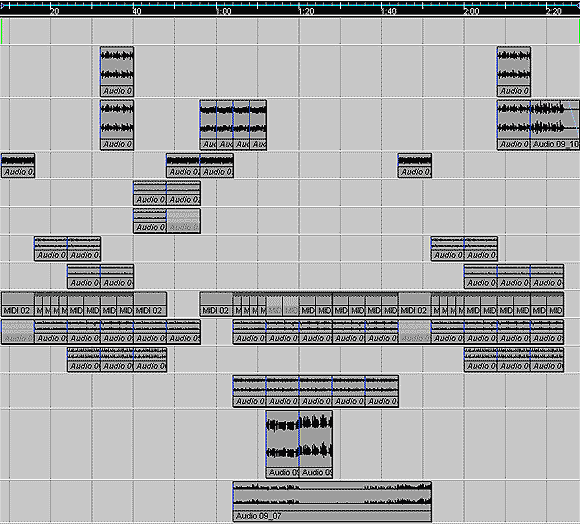
Matt Stoller of MyDD has been following the Connecticut senate race, as a Ned Lamont supporter, in the aftermath of the primary when Lamont whupped the odious Joe Lieberman. It's not looking too good--polls show Lieberman, now running as an indie, ahead. Stoller says this:
I've developed a keen respect for Senator Lieberman over the past few months. The man is completely brilliant, probably the best politician I've ever seen up close. When he wants something, he goes and gets it. He's not just a great politician, he's an extremely skilled sociopathic charmer, able to appeal to one's worst instincts while making you feel like he's helping create resolute moral tone. Lieberman is the consummate small state politician; he has the press here wrapped around his finger, and he is able to create an aura of trust and geniality wherever he goes, even as he calls for regime change in Iran and sends his voters' children to be maimed for his own pride. It's a stunning feat. So the challenge is great, and it's not supposed to be easy, because convincing the public that they have been voting for a psychotic man divorced from the consequences of his brutal actions is really tough when that creepy package is delivered in a Happy Meal.I believe Stoller is learning on the job that Holy Joe is a "consummate small state politician." The progressive narrative during the primary fight was that Lieberman had "gone Washington" and lost touch with his constituents.
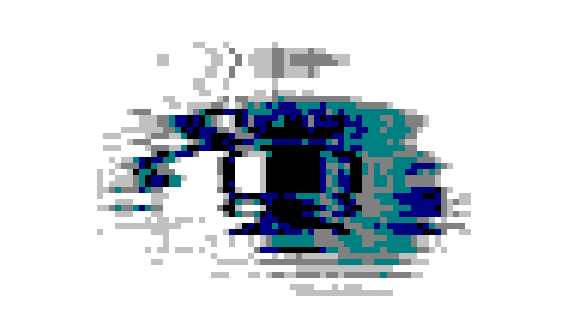
In "How to Make a Power Grab Mundane," in Editor and Publisher, James Bovard nails the bland language the Washington Post used to describe the enactment of the Bush/McCain torture law:
The Military Commissions Act is widely seen as legalizing torture, but the article avoids any such mention of the T-word. Though the act revolutionizes American jurisprudence by permitting the use of tortured confessions in judicial proceedings, the Post discreetly notes only that defendants will face “restrictions on their ability to ... exclude evidence gained through witness coercion.”Court challenges to this horrible law will need to be robust and unceasing. Let's hope the civil rights bar is up to the job, since we obviously can't count on newspapers to protest the dismantling of Constitutional protections of freedom and individual rights.
The lead of the Post article declares that the new law will “set the rules for the trials of key al-Qaeda members.” A typical subway strap hanger reader might shrug at this point and shift to the Sports section to read the latest autopsy on the Washington Redskins. The Post neglects to mention that the bill codifies the president’s power to label anyone on Earth an “enemy combatant” -- based on secret evidence which the government need not disclose.
Almost let Brian De Palma's The Black Dahlia slip out of the threatres, noting the so-so reviews, and then remembered, with a forehead slap, he always get bad reviews--until 5, 10, 20 years later, then everyone loves his work.
It's awesome. Yeah, yeah, Josh Hartnett and Scarlett Johansson are wooden, so what? You don't go to this man's films for the acting--it's adequate. With De Palma it's the architecture, the slithery camera unhinged from narrative (or so we think until it reveals something important), the overwhelming sense of place, the visual clues and puns, the high camp melodrama, the intricately worked out geometry of every scene. The shot of the creepy slum houses under the "Hollywoodland" sign alone brings James Ellroy to life, but the "discovery of the body" scene takes his tawdry view of tinseltown to a whole other macabre level. The movie is shot on digital video but it feels big screen ambitious.
Go, go tomorrow. Be sure to look for Mia Kirshner as the Dahlia--she played "the babysitter" in Atom Egoyan's Exotica and seems forever on the verge of a major career. May she be another Jennifer Connelly blessed with a "late break." She's really good.
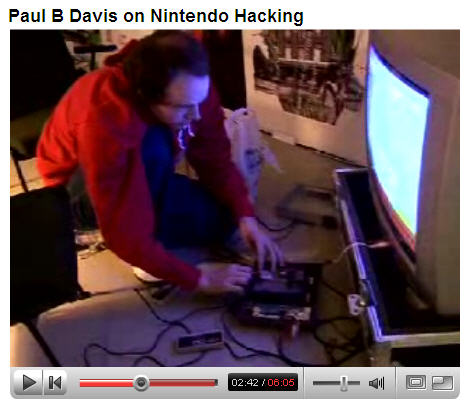
YouTube: "Produced by Hit 'n' Run [for Dutch television], this interview took place with Paul B. Davis from the BEIGE collective at the 35th International Film Festival Rotterdam. Paul exhibited a piece at the exhibition 'Satellite of Love' produced by Exploding Television. Here he talks about his Nintendo Cartridge Hacking."
Davis' delivery is very dry and funny in this video, and he has some great things to say. He and fellow artist Cory Arcangel, through their work with the BEIGE collective, have both been active proponents of busting open game cartridges and reprogramming the chips (though perhaps in a less aggressively activist way today than a few years ago--but that's another post). While gaygamer.net calls Mary Flanagan the "secret heart" of the movie 8 BIT, I don't really agree with that. (As mentioned earlier, Kristin Lucas's work would have been a catchier example in the film to show the psychological effects of life in a high-speed technological world--her late '90s videos incorporating game and sci-fi tropes are at once disturbing, aesthetically engaging, "lo fi," and presaged many themes of what might now be called the 8 BIT movement.)
No, if the movie has a secret heart, it's why Arcangel and Davis, who used the phrase "8 Bit" in an LP title five years ago and are sort of the poster children for the current scene, started hacking Nintendo cartridges in the first place. Davis was always the more political of the pair in how he speaks about it, but he makes an interesting point in this YouTube vid: that untapped aesthetic potential exists in everyday gear that is meant to be inaccessible to us. As he describes it, the "cheapest, highest quality audio and video generation system you could get" is locked up in a proprietary system that mostly sits in your closet. Although its hardware and software constitute a complete or "general purpose" computer, it only does one thing, which is play this one particular brand of game.
This is what I would call the "ecological" argument--a wry complaint addressed to the consumerist waste that is the bedrock of our capitalist system and represents a condition that simply will not go on forever, as resources dry up and the planet turns into a sewer. To some extent the 8-bit scene gives a glimpse of artists we will have after the Fall: patterned on archetypes like Gilligan's Island's Professor or Escape from New York's Brain, they will squeeze "energy dependent culture" out of a diminishing stock of manufactured products. Yet the BEIGE crew is doing it now, while we're still awash in plentiful, working consumer electronics. Their suggestion that "anyone can hack cartridges" also recalls Robert Pirsig's '70s self help book Zen and the Art of Motorcycle Maintenance, which argued for people taking back some control in their technologically dependent lives. Of course, the BEIGE work is goofy and fun, too--it's not as Earth First!-y or New Age as I'm making it sound. Here is an excerpt from an early manifesto, written by Davis; it would have been nice to hear more of this in 8 BIT:
Bereft of a veneer, interaction with such complicated machinery requires a significant amount of technological knowledge and awareness. In this spirit, "Fat Bits" represents a step towards what Cory and I describe as "Post-Data". We create computer art which is aesthetically aware of both its own identity and the underlying process which supports it - that is to say it recognizes the fundamental prototype of the "computer", and not the "software", as the tool and medium. The content for "Fat Bits", video of a NHL hockey fight, was chosen because the close-up nature of its imagery makes for convenient replication on low-resolution systems such as the Nintendo Entertainment System. The use of the Nintendo Entertainment System is itself important because it, firstly, signifies an artistic "re-licensing" of proprietary corporate technology and, secondly, refutes Nintendo's forced obsolescence profit structure which defines it as "outdated" (the Nintendo Entertainment System was introduced to the US home video game market in 1986). Our primary foundation of Post Data is then this: the conscious corruption of data, the releasing of bits from their imprisonment within the restrictive, limiting boundaries of corporate software applications, and the exploitation of the extreme complexity of computer systems paired with the extreme intentionality of artist(s) who seek to engage the computing process at a fundamental level.
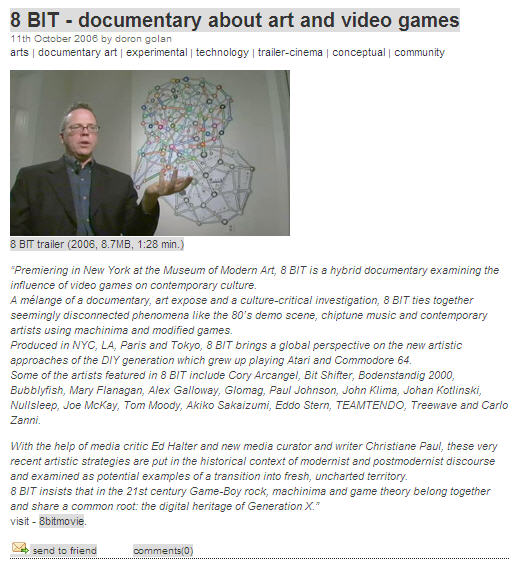
Thanks to DVBlog for this post with a screenshot of some guy in the 8 BIT trailer (widescreen Quicktime version, no longer viewable on the 8 BIT website)
Speaking of DVBlog, jimpunk has excellently remixed the 8 BIT trailer at DVBlogh4ck.
My post on the Paul Slocum and Cory Arcangel performances at vertexList gallery has been updated, to account for various meta levels I missed the first time around. I can't promise it won't happen again.
Paul has posted some photos of the event here.
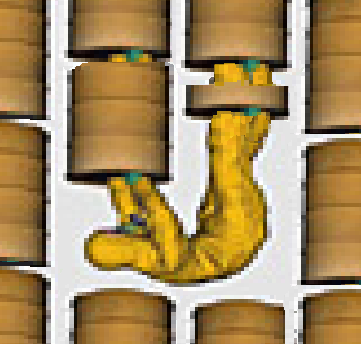
For "player hating" at its best, check out writer Daniel Mendelsohn's acid spew all over Jonathan Franzen's book The Discomfort Zone in the current New York Times. I haven't read the book but the review gives me hives. Mendelsohn goes right for the personal, zeroing in on Franzen's pop culture breakthrough moment, the supposed gaffe in declining to be an "Oprah author," while brushing past the merits of that controversy. For concern troll Mendelsohn, what made Franzen a "tragic" figure wasn't that TV triumphed over literature but that Franzen lost book sales. So, is Mendelsohn reviewing a book or an individual? The latter--he never lets up. One might expect a memoir written by a fiction writer to shade truth with some degree of persona fabrication. Yet to Mendelsohn, Franzen is simply "self-involved," with a "humorless" authorial voice that irks him mightily. Without reflecting on how his own buttons might be getting pushed (maybe it's, you know, craft, or maybe Mendelsohn's mother is like that), he stays on the ad hominem trail. When Franzen's virtues are mentioned it's usually a setup for another sledgehammer blow.
And Mendelsohn's writing is bad. He describes The Corrections, the Oprah candidate in question, as "an acerbic and often searingly painful dissection of one Midwestern family’s disintegration as its stodgy values [a]re put to the test by the go-go avidity of American culture in the 1990s." "Go-go avidity"? What does that mean? Mendelsohn declares Franzen's "wider failing" to be his "lack of humanizing softness." One wishes Nabokov, Beckett, and Richard Ford could be nicer too--more "human." Mendelsohn spends two paragraphs proving that Franzen is "wrong" about the comic strip Peanuts. He isn't saying that Franzen's identification with Snoopy over Charlie Brown is a failed literary conceit but, rather, a sign of his deep moral failing as a person. Maybe Mendelsohn is right, and the book is Franzen, with no writerly intervention whatsoever. As I said, I haven't read it. Mendelsohn's envy and aggression in the service of increased human sensitivity, however, is something I wish I hadn't read.
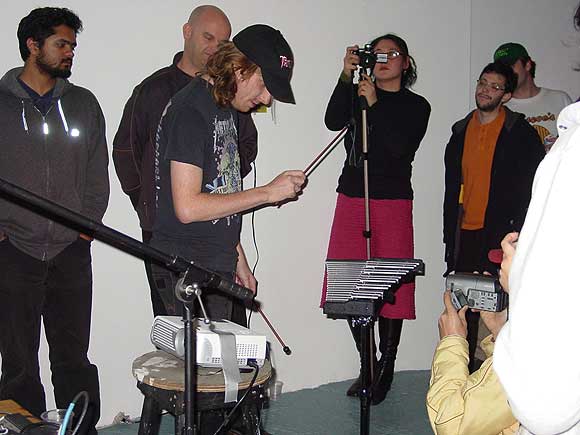
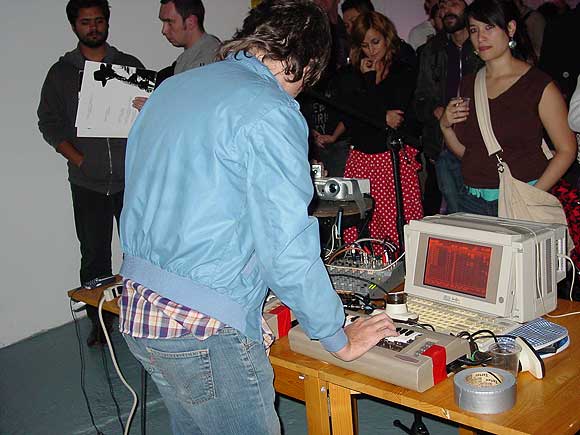
Top: Cory Arcangel plays some glockenspiel parts he added to Bruce Springsteen's Born to Run, at vertexList last night. You may or may not know that that record already, in fact, has glockenspiel on it--it's the tinkly, xylophony sound that Springsteen included on some songs, along with strings, to make the music more "produced," orchestral, and/or Phil Spectorish. I didn't know it, but I have a hard time caring, since I don't like Bruce Springsteen's music at all. I also don't know what Arcangel's relationship is to that music, or the glockenspiel--ironic? admiring? a little of both? In any case, for this performance, he played over the album, karaoke-style, pinging poignantly on the glock in a milieu that might be described as "Dada meets the hits of the '70s meets mallet instrument fan fiction." Whatever I think of Springsteen, I enjoyed the effect this patience-testing performance had on the crowd, which perhaps wasn't expecting something so modest, or arch, from an artist known to do surprise virtuoso pieces.
In the bottom photo, Paul Slocum more straightforwardly rocks the audience with his '80s home computer ensemble--note piano keys positioned over a seriously fat QWERTY keyboard. Unlike others in the plinky, fun, 8 BIT school, Slocum makes dark, dense, dreamlike music--a la the Velvet Underground, only with chipdrones instead of guitars and a rhythm box instead of Mo Tucker. Pedal effects to boost the volume and filter sweeps to bend the notes create an engulfing wall of sound. You can hear tunes within tunes inside all the distortion. The occasion was the opening of his solo show at the gallery, and he was playing without his usual Tree Wave partner Lauren Gray. Her vocals were missed but the performance (and his show) were excellent. Also in the exhibit is Slocum's piece Deep House for Symphonic Band and Choir, 2006. It was great to see it in person and confirm this favorable preReview.
(BTW, the woman to the right in the picture isn't giving the photographer a significant look, I swear-- she's watching the mesmerizing, Slocum-designed, psychedelic pixel display on a wall-projection behind me. No, really.)
Updated several times with new info and thoughts.
"Psychic Highway" [mp3 removed]
Update: I thought it needed one more thing so I added that thing. (Some mutated Sidstation stabs at the end--it's still very minimal and acid-y.)

very cool "tattoo skull"--artist unknown
Reviews of 8 BIT are coming in--so far, except for The Reeler, they've all been from the game world. There's one at Game Set Watch, and another at VH1 Game Break. While enthusiastic overall, these game scene reviews seem ill-at-ease or defensive about the film's art context. The writer at gaygamer.net, however, is comfortable talking about that and makes some good points about the movie's relationship to art theory, e.g.:
...[A]rtist/scholar Mary Flanagan approaches the topic from a more theoretical level, which is incredibly helpful to an informed outsider but also frustrating simply because theory, especially when coupled with too much deconstructionism, can pretty much be death to art and creative thinking. Maybe that’s just the chip on my shoulder. Flanagan, at any rate, asks some really important questions about the impact of games and gaming technology on our culture and, therefore, on ourselves, and she seems eager to stress how important is it not to allow these questions to go unanswered. Peel away the temporary DIY art-trends and this moment with Mary Flanagan is the secret heart of 8 BIT.I like the way the relative "hotness" of the movie's talking heads comes in as an evaluation criterion in this review. (Alex Galloway, call your agent.) It's true, some folks featured in the film are exquisite and that might subtly affect how you view the subject matter, but mostly it will not be mentioned by critics. That is, since it's supposedly a documentary and not a star-driven movie. Elements of the latter inevitably creep in, though, especially when the cast is as well-lit and shot as they are in 8 BIT. The two films I would most compare 8 BIT to are Painters Painting and Iara Lee's Modulations. Concerning the latter, I remember a friend commenting that "the British critics (Simon Reynolds and Kodwo Eshun) have beautiful mouths and teeth." When you're sitting in a dark room and the parts in question are enormous, you notice these things.
The film spends a little too much time proving it knows it’s beyond modernism and postmodernism, which is both an easy out and obvious, and therefore boring. I would have liked a little more talk about what the creative movements going on in 8 BIT mean for the future of this strange crossroads between games, technology, and art, and a little less PoMo (or po-PoMo, I guess), but on the whole 8 BIT rocked my world. If you’re an art dude, a game girl, a culture maven, a theory freak, or just plain interested, you’ll be glad you saw it.

Kung Fu Baby [750 KB .GIF]
Ee-e-e-oh-wa... (etc)
I happened to catch this young master on cable and was delighted to see that the artistry continues on the Net.
It's fall, and that means it's time for another installment of Thor Johnson's Texas State Fair Photos. The collection is here: [2.6 MB flash file]. And below are a few examples. I never cease to marvel at the overeating epidemic that seems to have struck the state since I left in '95. More of Johnson's photos, videos, and music here, and an earlier post on him is here. The photos really strike a chord with me--they're like the perfect combo of love and hate, sarcasm and pathos. It's unusual to see this kind of clarity of vision in a photographer--most get all absorbed with technique, as opposed to being a raw, outraged eye opening itself up to all the available stimuli in an environment like this. Somebody could probably take the same "kind" of photos at Coney Island in NY, but I don't think anyone here hates Coney Island or its denizens. Whereas, Texas (especially Dallas, where these are taken) has this layer of righteousness that suffuses ordinary ignorance and exploitation, making it seem more pernicious. I know Johnson loathes the false piety but as I said, there is also love in these photos. I went to the State Fair a number of times and it was always a kick.




Trailer Park Boys on YouTube (a fine Canadian export--much better than American TV, IMHO).
The "What in the Fuck Happened to Our Trailer Park?" episode, with all the bad language intact. Unfortunately the sound drops out 2/3 of the way through Part 1, but by then you've seen enough to skip ahead to Part 2. There's more to this episode but I can't find it.
Some indispensable SCTV YouTubes. Watch'em before the Man steps in and shuts down our fun.
Jerry Todd - Video Dating
"Just because you love video doesn't mean you can't love a human."
Jerry Todd - Video Dinner
Ride Like the Wind
The original "yacht rock" parody.
Garth and Gord and Fiona and Alice
Until about 3 years ago, this was all I knew about Canada.
Part One
Part Two
Whisper of the Wolf
Count Floyd screens "scary" Ingmar Bergman parody ("Who booked that? Prickly, was that you?")
Yellowbelly
Caution: not parent friendly.
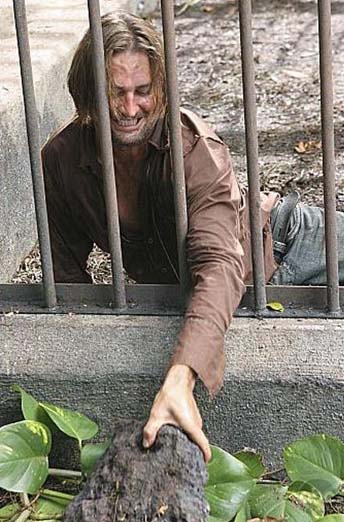
Notes on the 8 BIT premiere at MOMA, Oct 7 (work in process)
--the 420-seat theatre was 5 seats shy of being completely full, I was told.
--My description of Game Boy music as "that tuneless stuff Malcolm McLaren likes" and Nullsleep's vituperative response from a live stage got a laugh. I'm resigned to my role as "the heel," as it is called in professional wrestling. Post-screening comments about that "battle" were interesting: a media critic who attended called it a "mods vs rockers moment" and a higher-up in a media arts non-profit said to me: "I was surprised--I thought you supported our music." I do, most of it--I guess this person hasn't been reading my blog lately.
--The movie favors a sociological, narrative, theoretical style of art. A different 8 BIT would tilt more to the crazy, pointless, Dionysian (but not wholly uncritical) side, represented by Paper Rad, who use game imagery and techniques extensively in their online and offline cartooniverse. Kristin Lucas's pioneering game-based videos emphasizing (Modernity-damaged, personal) psychology over Marxist socio-crit could also be included.
--Rumor has it JODI footage will be inserted--I love them, but they were established Internet-dismantlers before they became game dismantlers (correct me if I'm wrong). They would be the logical centerpiece to 8 BIT: The Return. 8 BIT already borders on long--not sure it can handle much more run time.
--If 8 BIT as currently constituted seems balanced (and it does), it is because the music clips and the montages of game "trash" supply the ebullient, anarchic counterpoint to institutional critique.
--the audience laughed at the funny parts and everyone seemed into it, including many who hadn't encountered Super Mario Clouds before.
--the movie is driven by excellent music and, as mentioned, relentlessly tasty videogame imagery--these are the glue binding together what is otherwise a series of (intermittently great) talking head interviews.
--Music-wise, Bodenstandig 2000 is a perfect mix of gritty chip tone techno-rave, Nitzer Ebb white b-boy rapping/chanting, and Laibach-ian Euro-gloom: they're accomplished "major label" musicians keeping it real with gear anyone can own. Snippets of other outstanding performances keep the film humming.
--the other thing that drives the movie is, once again, a busy visual sensibility centered on games. This has less to do with the individual artists featured than the producers' in-depth research and use of found clips that show a real love for the idiosyncrasies and poetry of games. This unified visual style supplies the feeling of an art movement--even when the artists actually have quite different backgrounds and intents. (I personally see the DIY, WTF work of Bodenstandig and the BEIGE crew as being opposed to the overdetermined, overproduced global capitalist apologetics of, say, John Klima.) Producer/Co-director/Director of Photography Justin Strawhand deserves special mention for this unifying use of images and clips mined from the net and creatively montaged. (Not to slight the contributions of Director and original concept-er Marcin Ramocki)
MOMA 8 BIT page (there's a second screening on Wednesday, Oct 11)
8 BIT website
Thomas Kean, Jr., running for Senate in New Jersey, turns his back on a woman whose son is serving in Iraq in this video. Watch him retreat across the room and leave his smarmy campaign manager to stonewall her. The latter looks like the type of arrogant personality that traveled to Florida for the "Brooks Brothers riot" during the 2000 election theft. Kean Junior is hoping that New Jersey voters will confuse him for his more famous father, who sat on the 9/11 Commission; the son is running against Democrat Robert Menendez, a much better choice for Senator.
Joan Didion has a good article in the New York Review of Books on Richard Bruce Cheney, one of the darker blots on American politics, who will be widely proclaimed as such if the U.S. ever returns to separation-of-powers sanity. He's not a blustering thug like Joe McCarthy or a conspicuous, out-front liar like Oliver North, but he shares their basic attributes. Didion gets at the peculiar way he has of screwing up and then profiting from it, while perpetually convincing everyone around him that he is super-intelligent and on the side of the angels. She points out the inconsistencies in his political principles, the only possible thread connecting them being the aggressive acquisition of power and wealth. She examines his statement about having "other priorities than military service" during the Vietnam draft era and the weaselly way he responded in the aftermath of shooting Harry Whittington in the face, making it seem like the victim's fault, and relates these utterances to the Administration's twisted and meaningless justifications for torture. It's a longish article but I recommend reading it and really thinking about this sharp (but ultimately dull) operator, and how we can prevent others like him from coming to power. One conclusion is he's a pure creature of Washington, his only real skill bureaucratic infighting within that cozy yet Byzantine environment. A reason he's so against government transparency is it allows creatures like him to thrive in the inky ooze. So--more openness in government. Constitutionally mandate a "VP blog" and make him spend a couple of hours a day answering direct questions from the people who pay his salary. I'd love to see his lying obfuscations taken apart by smart interlocutors on a comment thread.

modified 544 x 378 WebTV GIF assortment
The Inner Life of a Cell. (Flash 8 vids in various res-es at the link.) Computer animations showing processes that occur in the cells of our bodies every day. A good '90s rave video, with late (i.e., symphonic) Tangerine Dream score instead of 303s by Hardfloor. Lots of molecular zipping and unzipping, oozing, probing, drifting through permeable membranes, and the occasional shameless anthropomorphization (I'm thinking of one little "keep on truckin" character dragging an enormous blob up a column--I believe the filmmakers that something at the subcellular level actually does that, but it still resembles Monsters, Inc.). The visual working out of intricate processes is more beautiful than the standard "translucent plastic" surfaces of the animation. The makers admit they added the vertiginous empty spaces so the inner world would be comprehensible. I like this mostly for the intuitive sense that we are all Rube Goldberg devices at the most basic level, and marvel that we function at all. Whoops, I mean, I Humbly Thank the Creator For His Most Intelligent Design. I'm sure it's not as fragile and kludgy as it looks.
"Aruba Doobie" [mp3 removed]
My contribution to the "yacht rock" genre.

More on the movie 8 BIT, opening this weekend at MOMA. The interview below is cobbled together from email questions Paddy Johnson sent me in connection with her Reeler article, and my responses:
PJ: Do you see yourself, and does the movie portray you as an artist working within the genre who is a counterpoint to a generation who has grown up with these influences? I would imagine that from this perspective your position as an artist and a critic would be key.
TM: My interview footage is used a number of times in the film. It's the wonky side of me that you see on my blog, analyzing, historicizing, and kibbitzing about others' work, mostly. (Sure to win me more friends!)
The movie title "8 BIT"--referring to a type of computer memory used in older machines--applies to art and music made with videogames, which the movie focuses on, but also the "lo-fi" tendency in new media art.
At one point in the film, Cory Arcangel talks about the different types of sounds that come out of different '80s computers. He and and the BEIGE crew used those sounds to make classic "electro" tunes that were not "videogame art" per se, but music proactively using the limitations of that old gear.
Working at the low end of computing is a kind of resistance to, or critique of, the high end--the ubiquitous domain of company-employed, non-artist experts.
The DIY, hacker, guerrilla mindset is a constant theme in the movie--the topic is bigger than videogames. One thing I like about the film is it casts its net wider than just a small scene.
PJ: One of the threads that runs through the movie is that because the medium is so new, we are still figuring out how to work with it. You briefly describe a progression of games pointing out that at each point along this time line artists could respond to the technology, but we haven't had enough time to deal with it all. This is very true, and the issue is compounded, I think, by the fact that technology changes so quickly that you can't respond to all of it. It seems to me one of the challenges new media faces is figuring out how to create work that has permanence in a medium that is constantly changing. Do you think this is happening?
TM: New media artists are fairly attuned to issues of what's gained or lost in the constant process of "updating" software and hardware. A lot of the in-jokes deal with the outmoded (Pong, MacPaint) or not-yet-moded (e.g., "vaporware"). The problem is arriving at a consensus of what's good and bad in the *art* (as opposed to just the tech), and then how to present this to the broader art world. That's where blogs are useful--these issues can be hashed out. I feel like I've found a peer group through blogging and the Net, which is overall more open and verbal than what I found with my peers in the art world. Films like 8 BIT are also helpful in defining the values of a "scene." What should be in the movie? What shouldn't? I've often said that since artists are not "joiners" by nature (i.e., they are self-absorbed holy terrors), when two or more of them agree on something it's usually significant. Then the rest of the world has to catch up.
PJ: Well, from that standpoint, I think this is an important movie for New Media, because it will help people understand how artists come to make the work they are making. For instance one of the commonalities among almost all of the artists was their interest in creating limitations and then working within these perimeters. Is this something that you feel is a result of the bias of the medium (in other words, programming requires a certain kind of thought process, so this desire stems from an interest in the way the medium works in the first place) or a larger cultural construct? Does this way of working influence your studio practice in any way?
TM: As for the larger cultural construct, yes, as I touched on earlier it's a kind of resistance to the more obnoxious principles of Modernity--planned obsolescence, buying new gear to keep up with the neighbors, proprietary software that controls you rather than the reverse--while still working with materials and processes that have something to do with the era you live in.
On a practice level, let's go back to the example of the '80s computer sounds the BEIGE crew's 8-Bit Construction Set record. One reason for using the older Atari and Commodore computers is that the sounds are excellent--gravelly, squelchy, very distinctively "low-res." Newer gear "improved" and got rid of some of those.
 I use an older version of the Windows MSPaint software to make artwork and animated GIFs. Partly I'm being "office ironic," but the program had a particular way of doing pixelated crosshatching that was "improved" in subsequent versions and lost. I don't use the program because it's older, but because it's actually better. These sound like "formal" issues, but a particular look or sound can be very important to an artist's work.
I use an older version of the Windows MSPaint software to make artwork and animated GIFs. Partly I'm being "office ironic," but the program had a particular way of doing pixelated crosshatching that was "improved" in subsequent versions and lost. I don't use the program because it's older, but because it's actually better. These sound like "formal" issues, but a particular look or sound can be very important to an artist's work. PJ: In the movie you talk about Game Boy music being tuneless, which of course upset a bunch of Game Boy musicians. Immediately following angry musician footage is a clip allowing you explaining that point further. But this clip consists merely of "What I meant by that is it's not interesting melodically." I thought it was an interesting editing choice, as I am guessing you had more to say on the point than this, it probably connected these thoughts on Atari and Commodore computers. Is this the case?
TM: Game Boy music was declared the "next big thing" by Malcolm McLaren, promoter of the Sex Pistols, a few years back. Just to be clear, because it may be a little confusing in the film, my comments didn't apply to all "8-Bit" style music or "chiptunes." Just the Game Boy subset of it--which gets its own section in the 8 BIT movie.
The Game Boy is more limited as a music-making device than say, the Commodore 64 chip, which has analog filters, ADSR (sound envelope) shapers, etc. It's a 4-bit, 4-channel sound chip, and almost all the music is made on it is done with the interface designed by the Swedish musician/hacker Role Model. The music's cute, but too much of it sounds like...a Game Boy, or worse, somebody randomly pecking around the keyboard. (Bit Shifter is, I'm told, the Segovia of Game Boy music, but I keep missing his performances.)
By contrast, what the BEIGE crew and Tree Wave do with the Commodore and the Atari is rich and complex--hacking the sound chips (or not) to make music with a greater range and a fuller sound in a performance context. Bodenstandig 2000 also shows the extremes of what can be done with chips and tracker interfaces--really nasty drum and bass, among other things.

In The Reeler this week Paddy Johnson reviews the movie 8 BIT, opening Saturday at the Museum of Modern Art. I'm in the film yakking a lot so this will be 8-Bit Week here at the blog. I'll post some back-and-forth email Johnson and I had re: the review (with her kind permission), and will give my own biased perspective on the film. Johnson notes that it's "the first movie of its kind to document and situate the 8-bit scene within contemporary art discourse," and quotes me as saying "the DIY (do it yourself), hacker, guerrilla mindset is a constant theme... One thing I like about the film is it casts its net wider than just a small scene." Meaning it encompasses a variety of lo-fi strategies for using the computer as an art making tool.
But what exactly does "8-bit" mean? In computing it can connote "small," "low res," or "old"--the second meaning interests me the most. Wikipedia says: "In computer architecture, 8-bit integers, memory addresses, or other data units are those that are at most 8 bits (1 octet) wide. [...] The Z80 and the MOS Technology 6502 8-bit CPUs were widely used in home computers and game consoles of the 1970s and '80s. Many 8-bit CPUs or microcontrollers are the basis of today's ubiquitous embedded systems.
"There are 28 (256) possible permutations for 8 bits.
"About 55% of all CPUs sold in the world are 8-bit microcontrollers or microprocessors."
It's about doing a lot with a little to reach the most, as I see it.
MOMA 8 BIT page
8 BIT website
image above is a detail from the poster by eBoy.

Digby has a good post about the "real reason the US is in Iraq," based on revelations from Bob Woodward's new book State of Denial. As we all know, VP Cheney and SecDef Rumsfeld were higher-ups in the Gerald Ford administration at the time the U.S. pulled out of Vietnam. Believing, as an article of faith, that the defeat was a result of hippies and "liberal media propaganda" and nothing else, these warped old specimens waited twenty-five years for the chance to get back into power to "do Vietnam right." "Getting back in power" meant biding their time until someone as limited mentally as the younger Bush got in office.
This all rings true to me. I know some people who come from the so-called "Silent Generation" of the '50s who believe everything wrong with America can be traced to the '60s counterculture: they viewed Clinton as a bong-smoking libertine and welcomed Bush Junior as the second coming of solid Christian values. No amount of evidence of Republican corruption (Enron, Abramoff), incompetence (the war in Iraq), skankiness (Mark Foley), etc. will ever convince these folks that the Republicans aren't the party of the angels. And no evidence of the good that came out of the counterculture (tolerance, civil rights, environmental awareness) will ever convince them that "dirty hippies" aren't the worst thing that ever happened in the history of the world.
We could feel sorry for them, but unfortunately their kind shows no sign of voluntarily relaxing its grip on power, so I'm afraid we must hate them, at least until they admit they were wrong about everything and promise to behave. It sounds "intolerant," but these people are scary.
A theorist who spoke in connection with the "Low Grade/Fuzzy Logic" show I was in summer before last is cyberfeminist Sadie Plant, who is probably better known in the UK than the US. I found these online notes on her book Zeroes and Ones to be pretty helpful. Apologies to Michael Connor, one of the "Fuzzy" co-curators, who I was talking to last night: the theorist Plant discusses at length is Luce Irigaray, not Julia Kristeva.
Jim Henley on the McCain Torture Act, just passed by the US Congress:
In many ways the military commissions bill is designed as a Get Out of Jail Free card as much as a plan for the future. It’s designed to indemnify government officials and employees against criminal prosecution in US courts for acts they’ve already committed, ordered or approved. And that’s all well and good for escaping prosecution in the US courts. But British officials have to answer to British and European Union law. The Hague is not going to care that the US Congress decided to arbitrarily define away much of settled international law on the treatment of prisoners. I’ve already suggested that this trap still waits [for] American officials once some foreign court wants to spring it, but for officials in other countries it’s a more pressing worry.
A previous post on computer geeks riffing on Jackson Pollock has been revised, with various editorial changes and the addition of a more Pollocklike Pollock image from jacksonpollock.org.
